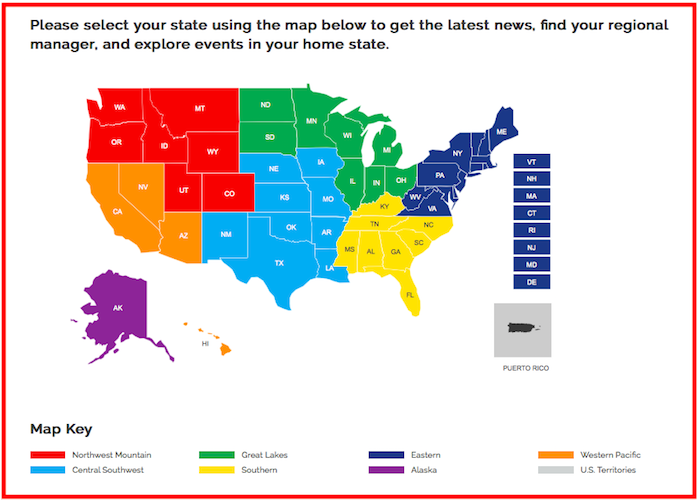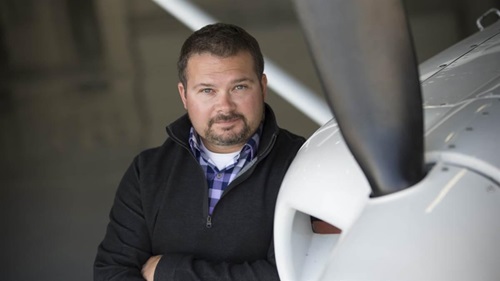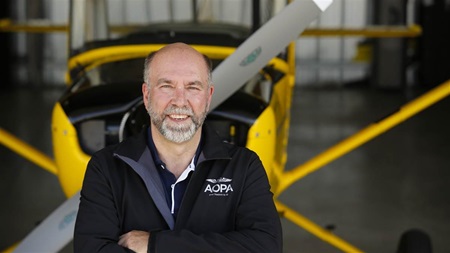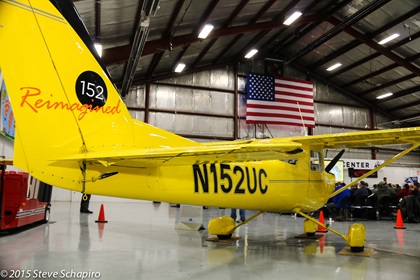AOPA headquarters may be in Frederick, Maryland but there are staff members all over the country that serve as a local resource to provide their knowledge and expertise to help members where you live. Flying club members are probably most familiar with the five You Can Fly Ambassadors, who assist clubs get started or existing clubs navigate any host of issues. But they also host Rusty Pilot seminars, work with high schools that are interested in adopting the AOPA STEM curriculum, as well as flight schools and other organizations.
In addition to AOPA’s Ambassadors, there are seven Regional Managers who work on airport issues and state legislative issues. The Regional Managers are funded by membership dues, they are part of AOPA, while Ambassadors and the You Can Fly Program are funded by donations through the AOPA Foundation.
This month we talk to the team that serves the Great Lakes Region, Ambassador Andy Miller based in Appleton, Wisconsin and Regional Manager Kyle Lewis based in Jackson, Ohio. They share what they do, how their positions differ, how they work together, and how they can help you.
Describe what your position is as an Ambassador or Regional Manager. What do you do and how do the positions differ?
Kyle: The Regional Manager is kind of like the jack of all trades of AOPA. We do a lot with general membership questions and issues that might arise as it relates to airports, rules and regulations as it relates to airports, even certifications – medical and aircraft.
The bulk of what we do is the legislative advocacy at the state level. We’re at the statehouses, actively engaged in that arena, and with state DOTs with any regulatory issues. That could include airspace issues, things like the tall structure permitting process, fuel taxes, or aircraft registration. We also do a lot of research for the large initiatives that AOPA has like the FBO and transparency issues. We’re out in the field, on the ground getting all that information so everybody at headquarters can make the right calls on what direction to go. That’s really the bulk of what we do.
Obviously the fun stuff is engaging with members. Whether it’s a fly-in or a regional event of some sort. We’re out there representing AOPA at all of those events.
How many regional representatives are there and how many states do they each cover?
Kyle: In my region, which is the Great Lakes Region, I cover eight states and they go from Ohio all the way out to North and South Dakota. All the states that touch a Great Lake plus North and South Dakota. Across the country we have six other Regional Managers and Alaska is considered a Region all by itself given all the unique issues out there.
I think the most states that anyone has is 13 and that’s our Northeast Regional Manager. He has all the small New England states, but it doesn’t take away from the fact that it is still 13 state legislatures that he deals with. Every region has it’s own unique issues. There’s California and Hawaii out west and in the Southern Region we have Florida, which probably has the most members.
Andy: The Ambassador has a lot of overlap in the areas that Kyle mentioned but one of the main differences is our focus as part of the You Can Fly Program is that we are working not only with members, but with other entities within the aviation community. So flying clubs are obviously a significant portion of our intention, but also schools that have the AOPA curriculum or might be interested in it. We often work with other organizations, such as EAA chapters, and airport and pilot associations, anyone who wants to promote general aviation. Part of the Ambassadors role is to help support and link them to the right resources at AOPA.
One of the coolest things is that being an Ambassador comes with an airplane. I have one of the AOPA Reimagined 152s, as do my colleagues. I take that to a lot of fly-in events pretty much every weekend [prior to the pandemic]. Depending on the nature of the fly-in, I’m talking to youth about how exciting it might be to get involved in aviation, sometimes I’m talking to pilots, including members, and sometimes the general public about why it’s important to support their local airport and perhaps be engaged in aviation at some level. And sometimes all of the above. It does vary quite a bit.
How many ambassadors are there nationwide and what areas do they cover?
Andy: There are five ambassadors and we do only cover limited areas. The vast majority of the country is not covered by an ambassador. [Flying Clubs Director Steve Bateman and Flying Club Manager Drew Myers cover the rest of the country for flying clubs.] I have probably the largest region with the Great Lakes, the six states that touch the Great Lakes directly. We have one in the northeast, Norm Isler who covers New York, Pennsylvania and a little bit into Ohio. Then in the south, Jamie Beckett covers central and northern part of Florida; Pat Brown is down in Texas and covers that triangle amongst Dallas-Ft. Worth, San Antonio and Houston, and Kay Sudaram is in Southern California.
How can an Ambassador or Regional Manager help flying clubs?
Kyle: Obviously the ambassadors deal directly with the flying clubs, but we often get questions when it relates to the governing of the airport as it relates to flying clubs. It could be someone from the airport administration asking can this flying club operate here as a non-commercial entity as far as minimum standards are concerned, or FAA oversight and how they view flying clubs. We answer those sorts of questions.
It takes a little bit of looking at a flying club to make sure it is operating as a true flying club and not a commercial operation. So that’s where there is a lot of collaboration between Andy and myself. When I get those kinds of questions I’ll usually link him in just to make sure he’s aware of what’s going on at the airport. He can help answer the specifics on the inner workings of the flying club. My role is to make sure the airport is comfortable with it and they know it is a protected aeronautical activity.
Andy: I’ll definitely reinforce Kyle’s point. You often have existing flying clubs or start up flying clubs that sometimes need their airport to receive a little education. There have been a lot changes to FAA policy relating to flying clubs and maybe people haven’t been updated on that or there are other agendas at hand. It’s very helpful to have government affairs expertise to provide that education, and it works in both directions.
The other side of it, which is wonderful, is a lot of times the flying club members are amongst the most active pilots at any given airport. They often know what’s going on. They will sometimes know of a potential issue before it becomes a huge problem. When they do call our attention to that kind of thing, that gives Kyle and his team the opportunity to intervene early. For example, a misguided effort to restrict access or things like that.
Kyle: As the Regional Manager we oversee the Airport Support Network (ASN), which is a volunteer at public use airports. They are the eyes and ears for their local airport and for the activities on the airport. So that’s something else that Regional Managers oversee. In my region, I have about 350 volunteers and we have just over 1,700 nationwide now and we’re actively recruiting.
Andy: I suspect a significant number of those ASNs are members of flying clubs. The goal is to have an ASN at every single airport and there are quite a number that aren’t covered yet. That’s something that you can look up on the AOPA website under Advocacy and see if there is an ASN already at your airport, and if not [AOPA members] should consider volunteering.
Kyle: The program allows AOPA to get involved in issues earlier rather than later. It’s not just bad issues, it’s all the good things happening at airports too that we like to highlight.
The volunteers may sit on an airport advisory board, maybe an authority or commission, or be on the tenants association or a flying club. We really like to see these people being active at an airport and being able to relay information to us if an issue does arise. That way we make sure we’re talking to the correct people and make sure we’re getting legitimate, up to date, current information.
Andy is actually our ASN for Appleton, Wisconsin (ATW).
Andy: Way before I was an employee at AOPA.
Kyle: Andy does a great job of outside of his AOPA duties of keeping me in the loop of things going on in that area of Wisconsin, not only in Appleton. If I have an issue with an airport up that way, he’s pretty well versed and with his local knowledge, he’s usually my go to for anything up there.
What are some of the common questions that you get asked in your position?
Kyle: The most common question I get is, “Can an airport do this?” Fill in the blank after that. Can an airport make me sign a lease? Can an airport make me empty my hangar and leave only the airplane? That is probably the most common question and sometimes it’s the hardest to answer because it’s all situational. It depends on what the airport rules and regulations may be and how they relate to FAA guidance, the airport minimum standards, which is kind of a governing document for commercial operators. But those commercial operators may be leasing a hangar or running a flight school or running an operation that is airport service related.
Andy: For the Ambassador, it really depends on the particular audience that we’re talking to. People that are interested in starting a flying club have one whole set of questions about that process.
Many of the kinds of questions Kyle was talking about will come to the Ambassador’s first. Things like when a misguided airport manager will try to have a restriction on the use of CFIs or expectations of paying fees, we’ll refer that over to Kyle and the government affairs group to provide some education.
The general public always wants to know how much it costs or how hard it is to learn to fly. The pilot population is still asking a lot of questions about Basic Med and the ramifications of that. Now of course people are asking a lot of questions about COVID and what we know. Government Affairs has really helped with that. They have a state by state guide to help pilots understand what the local regulations are. It’s really not an FAA issue at all, it’s a local issue, which makes it much harder for the pilots.
What is a question that you wish you would get asked?
Kyle: I think that question is “How can airport users, tenants, pilots help themselves?” Probably one of the things that I learned when I started in this position is that you can’t always give the answer that you want to give. Somebody may have really good intentions, it’s a really good idea…but. Or they think they are right. They think their position is 100 percent correct, but when you really look at the issue there are always two, three, four sides to a story. Sometimes they are on the wrong side of that. I think the question I wish I would get more is, “This is what I think. What is right?” and “How do I get to the right answer?” rather than some members or pilots starting with “I’m right, how can you fix it?” So you kind of have to work the problem backwards a lot of times.
Another question is, “How can the pilot, members, or the audience we’re speaking to help themselves?” Not that we’re not happy to provided assistance, but sometimes it leads to an answer they don’t like.
Andy: Certainly for flying clubs that are trying to get started, the question that I wish they would ask is about corporate structure. It seems so many of them get bad advice from their friend or their brother-in-law or sister-in-law who is an attorney and they form as an LLC and that just isn’t workable as a flying club in most cases. It’s a lot of work to correct that problem. From a start up flying club, that’s the question I wish they would ask the most.
For a lot of the audiences that Ambassadors work with, I agree with Kyle, I wish they would be a little more proactive. They all recognize the need to get more people in aviation, they recognize the need to make our airports more sustainable, but they don’t seem to be ready to make that decision to get involved and do something about it, as opposed to just observing that there is a problem. I’d like to see them become active instead of passive.
How do Ambassadors and Regional Managers work together? Give a specific example, maybe a club that had an airport issue or something you worked on together to get resolved?
Kyle: I’ve got a perfect example. In late 2018, we got a phone call from a skydive operator in Michigan. He said are you aware of this legislative bill that had been introduced into the Michigan House of Representatives. It had literally been introduced that day and I hadn’t had a chance to take a deep look at it. So I read it and it was just horribly written. It would have restricted operations on private airports to 10 operations per day and also classify flying clubs in the state of Michigan as commercial operators. It didn’t make much sense.
In more conversations with the skydive operator, I learned it was really based around his operation and some people complaining. It really had nothing to do with private airports because there are skydive operations at private airports and public airports. It was very misguided legislation and the hearing was in just a few days. So I reached out to Andy and said, “I’m working this issue. How can we work together?”
Immediately Andy made some phone calls and emails to flying clubs in Michigan. We had a very good showing at the hearing – about 35 members, pilots, agriculture operators, medevac crews, and hot air balloon operators. Obviously the skydive operator was involved, and some private airport owners, with the help of Andy. I don’t think we would have had that much support without Andy’s involvement. The bill was killed in committee.
That’s my really good example of the network between advocacy and the legislative side of things and the member outreach with flying clubs that the Ambassadors have. That was a really positive outcome. Working with the state level associations and even local associations is very beneficial.
Andy: The best example from my side is a case that a flying club was told by its airport manager that the members couldn’t have individual SIDA badges, the TSA issued badges for access. Kyle, and some of the other people behind him, very quickly helped the airport manager understand that they really can’t do that.
Similarly, I can think of at least three or four cases in the past few years when an airport manager would try to restrict a flying club from using the CFIs of their own choice and instead make them use the local flight school’s CFIs. That would be against FAA policy because members of a flying club need to be treated as if they are individual aircraft owners and individual aircraft owners can hire any CFI they want. The same is true for flying club members.
It can be helpful to have the power of the government affairs office knowing the lingo. They can drop the references to the regs and the FAA guidance and pretty quickly let the airport operator know they are talking to people who know what they are talking about. It works out really well.
Another thing we do is just help each other out. We had a flying club in the Columbus, Ohio area and Kyle was very happy to give a presentation. And vice versa, I’ve helped by standing in for him at some airport meetings even though it’s outside my technical responsibilities. We help each other if we’re spread a little thin.
We communicate a lot. Almost every week we brief each other on the issues we’re working on throughout the region. It’s very helpful to be on top of everything.
One of the things that Ambassadors work on the most is Rusty Pilot Seminars. Before COVID, the Ambassadors would give seminars frequently. A lot of my Saturdays were going to an airport at the invitation of a flying club who was hosting a Rusty Pilot Seminar. They are wonderful opportunities for a flying club to do something good for the pilot community, and from a marketing standpoint, make themselves more visible. 
What is the best way for people to contact you?
Andy: For all of the Ambassadors we welcome contact in whatever is the most convenient form for the pilot. Email is great ([email protected]), phone is great. All of the contact information is on the web site, there is a page for all the Ambassadors that can link through to us.
Or they can call the I-800 number (1-800-872-2672) and say I want to talk to an Ambassador or a flying club person. If they say flying club, it will get routed to Steve and Drew. If they say Ambassador, the Pilot Information Center person will typically do a little research and route the call to the right Ambassador. I’ll take calls from places like Iowa or the Dakotas just to help out. We’re not very firm on these territories. It’s more of a workload issue and we can’t do everything that we wish we could.
Kyle: The best way to contact me is email at [email protected] or through my office line, which usually rings through to my cell phone during business days 301-695-2229. All of the Regional Managers contact information can be found under the State Advocacy Tab on the web site.
Ambassadors
Jamie Beckett, Florida [email protected]
Pat Brown, Texas “Triangle” [email protected]
Kay Sundaram, Southern California [email protected]
Norm Isler, Northeast [email protected]
Andy Miller, Great Lakes [email protected]
Regional Managers
Tom George, Alaska [email protected]
Tom Chandler, Central Southwest [email protected]
Sean Collins, Eastern [email protected]
Kyle Lewis, Great Lewis [email protected]
Josh Pruzek, Northwest Mountain [email protected]
Steve Hedges, Southern [email protected]
Melissa McCaffrey, Western Pacific [email protected]